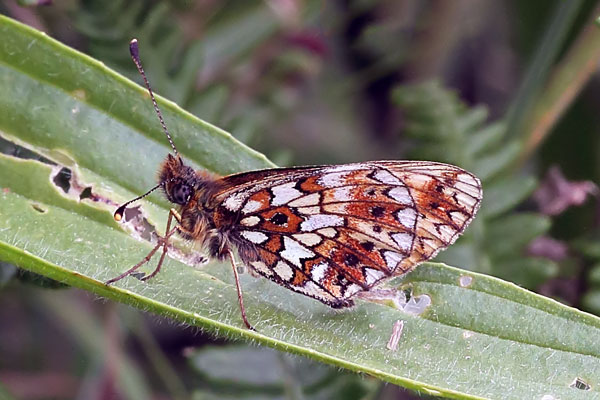Small Pearl-bordered Fritillary (Boloria selene) | Species | ||||||||||||||||||||||||||||||||||||||||||||||||||||||||||||||||||||||||||||||||||||||||||||||||
 Male. Taken at Arnside Knott, Lancs, on June 23rd 2022, (1/1000th sec at f14. © David Hastings)  Male underside. Taken at Heddon Valley, Devon on June 16th 2015. (1/500th sec at f13. © David Hastings)  Female. Taken at Bentley Wood, Wilts, on June 9th 2013. (1/50th sec at f11. © David Hastings)  Female underside. Taken at Bentley Wood, Wilts, on May 31st 2012 (1/100th sec at f11. © David Hastings) DescriptionFamily: Heliconiinae Wing span: M 35 - 41 mm; F 38 - 44 m This butterfly gets its name from the series of 'pearls' which run along the outside edge of the underside of the hind-wing. It is similar to the Pearl-bordered Fritillary but has all-black post-discal spots on the hind-wing underside. It occurs throughout Scotland and Wales, and in the western and southern counties of England. It is absent from Ireland. Most English colonies are found in open areas within deciduous woodland. These colonies are generally small, consisting of a few dozen adults at most, and these only have a limited capacity for colonising new areas. Colonies in the north are also found in more exposed situations such as marshland and moorland. These are larger colonies, typically spread across extensive areas of land, and butterflies in these colonies are relatively mobile as a result. In Cornwall, colonies occur on moorland and cliffs. At all sites damp areas are preferred, which the larval food plants need for vigorous growth. In the south-west of England, adults begin to emerge in early May. Elsewhere in England emergence begins in mid-May, and continues to the end of June. In good years there can be a small second brood at sites in the south-west of England. In Scotland there is only one brood, from mid-June to the end of July. The larva is the over-wintering stage. The larval foodplants are Common Dog-violet (Viola riviniana) and Marsh Violet (Viola palustris) Adults feed primarily on Bugle (Ajuga reptans). Male Small Pearl-bordered Fritillaries patrol a couple of feet from the ground, alternating a burst of rapid wing beats with a short glide, searching out freshly emerged females in the surrounding scrub. The wing pattern makes the adult butterfly difficult to follow in flight, and it is much easier to observe when it is basking or nectaring on flowers of Bugle and other plants. Near Threatened Sightings
| |||||||||||||||||||||||||||||||||||||||||||||||||||||||||||||||||||||||||||||||||||||||||||||||||
